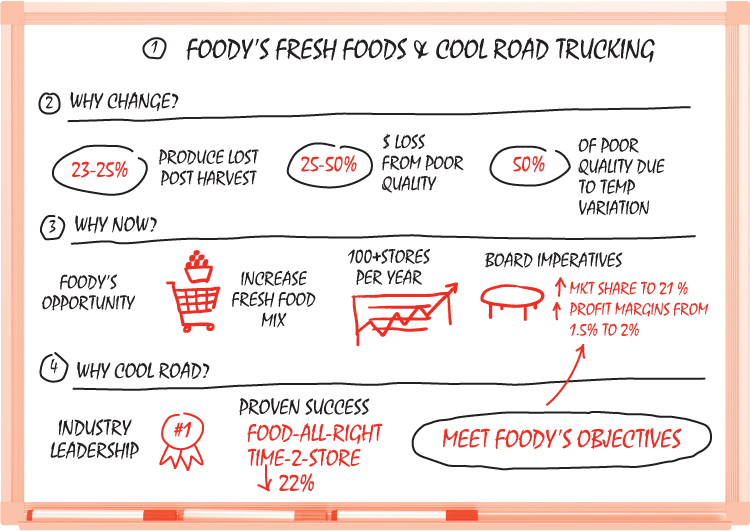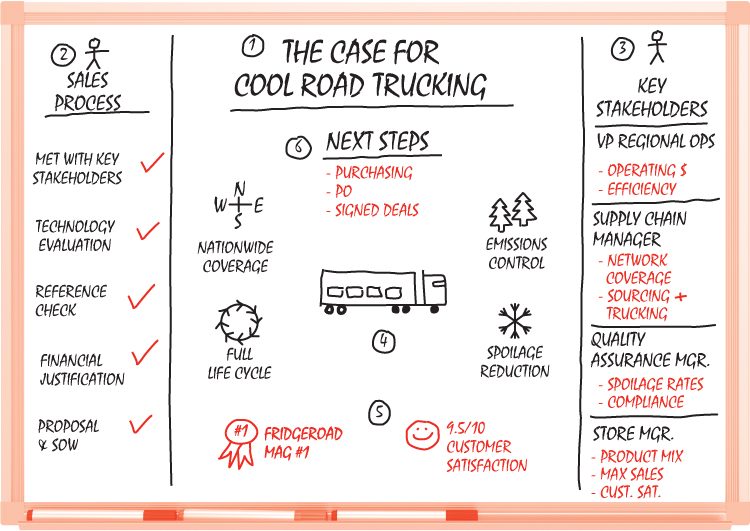Figure 16.1 The Why Change, Why Now, Why Us Whiteboard

Because only one thing counts in this life: GET THEM TO SIGN ON THE LINE WHICH IS DOTTED.… Money's out there. You pick it up, it's yours. You don't, I got no sympathy for you. You wanna go out on those sits tonight and close, CLOSE. It's yours. If not you're gonna be shining my shoes.
—Blake (Alec Baldwin), Glengarry Glen Ross, 1992
A–B–C. A for always, B for be, C for closing; always be closing—always be closing. Those famous lines reverberate through the heads of many a salesperson whose manager has sent them the video of that famous scene for which Alec Baldwin was Oscar-nominated. The point of sharing the quote is not that a Closing Whiteboard must always be used, or that it should be used as a hammer. It is simply a reminder that there comes a point in the sales process where you have to bring closure and ask for the business.
The Closing Whiteboard is often used in front of the ultimate economic decision maker, and it's designed to encapsulate the most salient points of previously delivered whiteboards used with lower-level champions or influencers. Necessary due diligence (reference checking, etc.), competitive differentiation in your favor, and preliminary financial negotiations should have already occurred prior to using this whiteboard. It's also important to note that this whiteboard may not be necessary, especially if you have been selling to the economic buyer during earlier stages in the sales process.
There are many approaches to closing a sales opportunity, none of which we especially espouse in the context of a Closing Whiteboard. Here are three of them.
Within the context of a consultative sale—especially when selling “enterprise class” solutions—these techniques may not prove effective. You will position yourself well to close by simply laying out the facts of your prospect's current situation, reiterating the consensus around information already provided, and solidifying your trusted advisor status through use of visuals and intimate knowledge of your prospect's business. Naturally, you can use any sales methodology or closing model you have found to be effective, but erring on the side of facts and consensus built so far using other whiteboards is fundamental to a whiteboard selling approach to closing a sale.
A good Closing Whiteboard is simply an amalgamation of several whiteboard types we have previously reviewed: Why Change Whiteboards, Solution Whiteboards, Competitive Whiteboards, and probably most important, a Business Case Whiteboard. They typically contain less information and follow the “Why Change,” “Why Now,” and “Why Us” model. Let's take a look at an example of a Closing Whiteboard, the Why Change, Why Now, Why Us Whiteboard. Each component of this whiteboard plays an important role in setting up the close.
Figure 16.1 The Why Change, Why Now, Why Us Whiteboard

ACTIVITY—Complete a Why Change, Why Now, Why Us Whiteboard Using a Current Prospect


You may be wondering, how would you conclude this whiteboard with a closing statement? You might try something like this:
Working with your team we have established a business case that demonstrates how Foody's and Cool Road Trucking can partner to deliver unique and measurable business value to positively impact the bottom line and help meet your strategic objectives starting today. We would like to earn your business and ask that you consider our proposal for approval today so we can begin achieving these benefits in the very near term.
Another example of a Closing Whiteboard summarizes the key stakeholders who have been met with, and a summary of the sales process to date. This approach is effective because it demonstrates to the economic buyer(s) that you have cast a broad net within the organization, making sure to communicate to all the key players how your solution addresses their specific needs and desires. The whiteboard identifies some key capabilities, but notice how it doesn't refer to specific feature names. The focus is on Next Steps to motivate action.
Figure 16.2 Closing Whiteboard Example #2

We've shared quite a few whiteboard template examples. In Part 4 we will dive into what it will take to leverage one of these templates to build a whiteboard using the whiteboard selling methodology and design best practices.